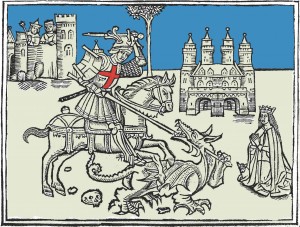Saint George is perhaps most famous for slaying a dragon. The most widely known version of the story was written by Richard Johnson way back in 1596. It’s titled ‘The Seven Champions’ and tells of a young St. George who is kidnapped by a witch and later sails to foreign lands to rescue a princess.

We have a fully illustrated children’s book about St. George and the Dragon that you can download (.pdf format, 1583kb). It’s based on The Seven Champions and ideal to read to your kids the night before 23 April.
As for the real St. George, some commentators have been sceptical in the past about whether he existed. However recent evidence has persuaded some scholars to conclude he was real. Here’s what we believe to be true:
- Born in Cappadocia, Turkey
- Lived in 3rd or 4th century AD
- His father was pagan and his mother was Christian
- His mother arranged for him to be secretly baptised
- Later lived in Lod or Lydda, Israel
- Became a Roman soldier
- Protested against the persecution of Christians
- Refused to worship the pagan gods of Apollo or Bacchus
- Imprisoned and tortured, but stayed true to his faith
- Died in Lydda
For more details download our History of St. George (.pdf format, 49kb).
St. George is possibly England’s most successful immigrant. Born in a foreign land, welcomed by the English, and has worked hard for over 800 years in his adopted country. He has integrated so well that he has come to symbolise the very essence of ‘Englishness’.
The story of St. George and the Dragon dates back to the Middle Ages when the dragon was commonly used to represent evil, so it’s an excellent tale of good triumphing over evil.
Since then St. George has been popularly identified with English ideals of charity, chivalry and courage (now known as the 3 C’s).
St. George’s worldwide fame
He is not only patron saint of England but also of…
|
|
In addition, he is the patron saint of soldiers, archers, cavalry and chivalry, farmers and field workers, riders and saddlers, and he helps those suffering from leprosy and plague. In recent years he has been adopted as the patron saint of Scouts and there are some who would like him to be the patron saint of same-sex marriages as he was referred to him some religious texts as ‘the bride of Jesus’.


